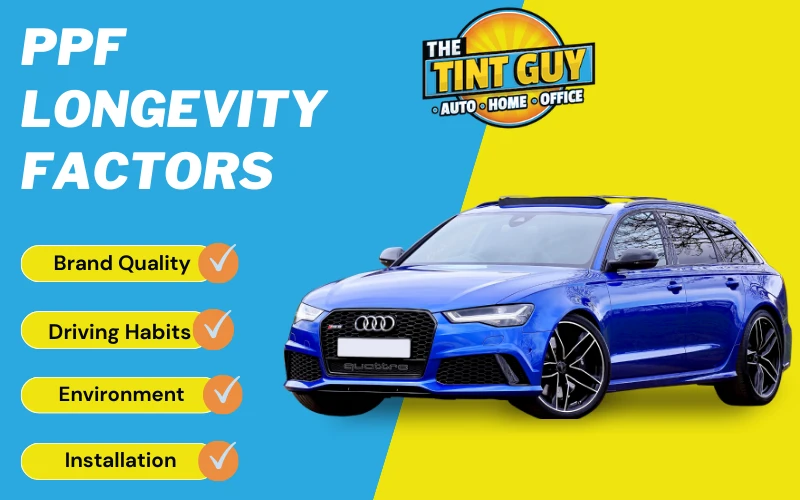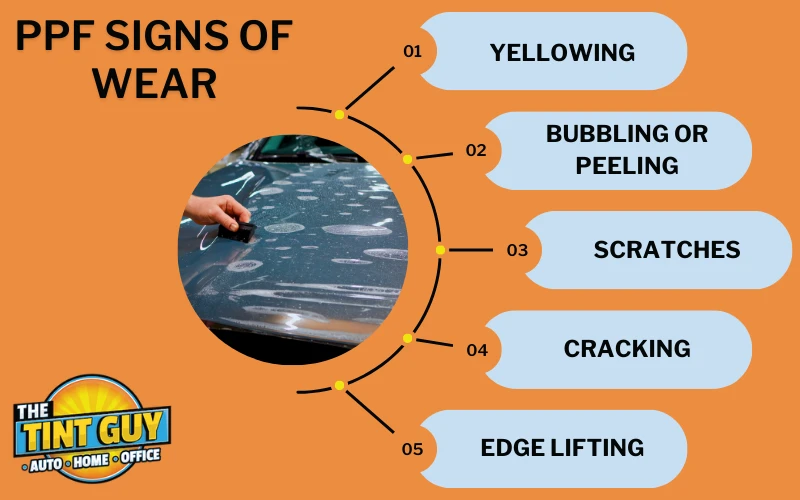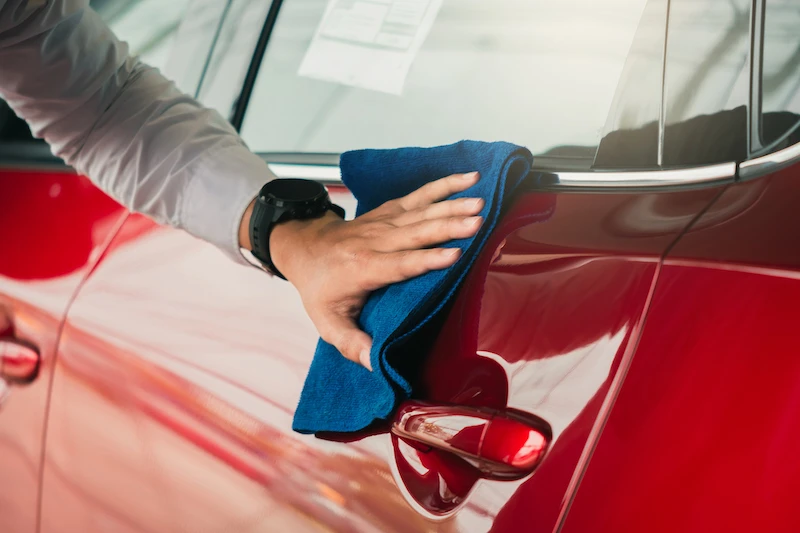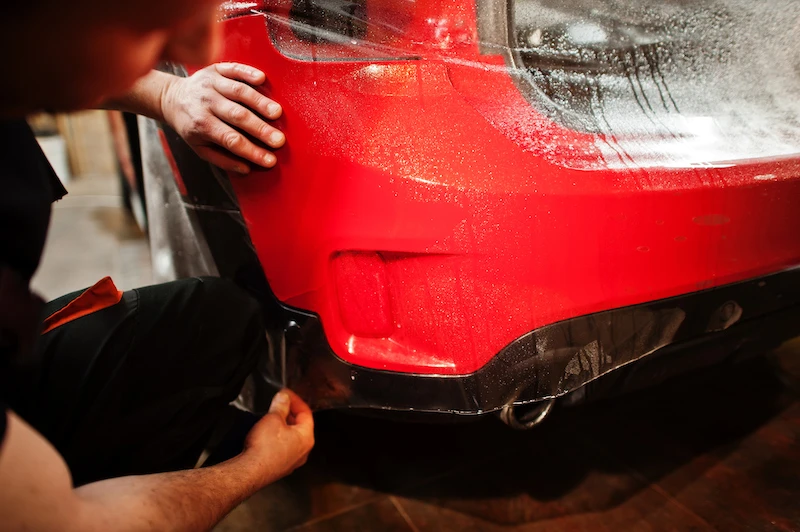“PPF can last up to ten years depending on various factors such as quality installation, environment, usage, and maintenance.”
In an era where your vehicle is not just a mode of transportation but a significant investment, preserving its aesthetic appeal is extremely important. Enter Paint Protection Film (PPF), a game-changing advancement in the automotive care industry. This virtually invisible film, also known as a clear bra, acts as a shield, protecting your car’s paint from damage caused by road debris, stone chips, minor scratches, and external elements. But before investing in PPF, you might be wondering how long will it last.
PPF is not just another accessory for your car; it’s a long-term investment in its maintenance and appeal. Designed to be durable, PPF can last up to 10 years. Yet, this is not a fixed-guarantee but a potential lifespan that heavily depends on a variety of factors.

Factors that Affect PPF Durability
Several factors play pivotal roles in determining how long your PPF will maintain its integrity and effectiveness. Understanding these can help extend the life of your PPF.
Installation: The Foundation of Longevity
The expertise behind the installation of PPF cannot be overlooked. Poor application techniques can lead even the most careful automobile owners to see their protective layer decline.
Brand Quality
In the realm of PPF, the brand is a major determinant of quality. Some films are thicker or have more advanced top coatings that offer better resistance to scratches, stains, and UV light, directly impacting their lifespan. We recommend LLumar’s Platinum Paint Protection Film stands because of its exceptional durability, clarity, and resilience. Choosing a reputable brand ensures that your vehicle benefits from the latest advancements in PPF technology. Plus, Llummar offers a 10-year warranty so you can rest assured that you are getting a PPF that will last.
Driving Habits
The roads you travel and how you navigate them can influence the longevity of your PPF. Frequent travel on gravel roads or through areas with construction can expose your vehicle to more hazards, potentially compromising the film’s condition. Driving in areas with higher UV rays can also contribute to the deterioration of your protective film.
Environmental Factors
Your vehicle’s environment plays a significant role in the lifespan of PPF. Constant exposure to direct sunlight, extreme weather conditions, or pollutants such as acid rain can accelerate the wear and tear on your PPF.

When to Say Goodbye: Recognizing Signs of Wear
Despite its resilience, PPF isn’t immune to wear and tear. Knowing when to replace your PPF is crucial in maintaining your vehicle’s pristine condition. Key indicators include:
- Yellowing: An evident sign of aging, yellowing compromises the clarity and appearance of the film.
- Bubbling or Peeling: These flaws suggest that the film is no longer adhering correctly, diminishing its protective qualities.
- Scratches: While PPF boasts self-healing properties, significant scratches may necessitate replacement.
- Cracking: Over time, exposure to harsh environmental conditions can cause the film to crack. Cracks not only detract from your vehicle’s appearance but also compromise the protective barrier of the PPF.
- Edge Lifting: This lifting can allow dirt, water, and debris to get underneath the film, potentially damaging the paint.

Maintenance Tips to Extend PPF Lifepspan
Proper care and maintenance are the lifelines of PPF. Regular cleaning, avoiding abrasive materials, and quick action on bird droppings and other stains can preserve the film’s condition and appearance.
To ensure your full PPF remains in like-new condition, follow these expert cleaning tips:
- Wash your vehicle bi-weekly with a pH-neutral cleaner and warm water.
- Use a plush microfiber towel to dry the vehicle to avoid scratches.
- Avoid harsh chemicals found in some cleaners as these can damage not only the PPF but your vehicle’s paint job too.
- Park under shade or use car covers to minimize UV exposure.
- Perform bi-annual inspections with a PPF specialist to identify any issues early.
Ceramic Coating vs PPF: Which is Best for You?
Ceramic coating is another popular clear coat choice for daily drivers. Ceramic coating chemically bonds with a vehicle’s paint and has hydrophobic properties. Unlike PPF however, ceramic coating only last about 3 years. Additionally, a ceramic coat does not protect against light scratches, rock chips, or other abrasions as PPF does. Ceramic coating allows for easier car washes, but without the protection and durability that comes with PPF. Learn more about the differences here.

The Importance of Professional PPF Installation
When it comes to paint protection film, the difference between a good and a great outcome hinges on the quality of the installation. It’s a specialized process that goes far beyond merely applying a film to the surface of your vehicle. Professional installation is crucial because it involves precise planning, careful preparation of the vehicle’s surface, and the meticulous application of the film to conform perfectly to the unique contours and curves of your car.
A professional installer brings experience and knowledge, ensuring that the PPF adheres correctly without bubbles, wrinkles, or misalignments. This expertise not only guarantees that the film is virtually invisible but also extends its durability and effectiveness in protecting your vehicle’s paint from scratches, chips, and the elements.
Moreover, professionals are adept at navigating the complexities of different vehicle models, which is essential for achieving seamless coverage. They use advanced tools and techniques to custom-fit the film, ensuring every edge and corner is covered, providing comprehensive protection that DIY kits and less experienced installers might miss.
Choosing a professional installation means you’re also benefiting from the installer’s in-depth knowledge of the product. They can advise on the best type of film for your specific needs, taking into account factors like your vehicle’s make, model, and how you use it. Additionally, professional installers often provide warranties on both the film and their workmanship, giving you extra peace of mind.
Unrivaled PPF Installations by The Tint Guy
With over three decades of experience in the automotive care industry, The Tint Guy stands at the forefront of PPF installation. Our commitment to quality, coupled with our expertise in utilizing top-tier LLumar PPF, ensures that your vehicle receives unparalleled protection. Schedule an appointment at our local shop in either Woodstock or Kennesaw locations.
Investing in PPF is a wise decision for any vehicle owner looking to preserve the beauty and integrity of their car’s paintwork. By choosing The Tint Guy for your PPF installation, you’re not just getting a service; you’re investing in peace of mind and the longevity of your vehicle’s aesthetic appeal.
Window Tinting Too!
At The Tint Guy, we’re not just about protecting your car’s paint; we also offer top-tier window tinting services for cars, homes, and businesses. Our high-quality tints not only enhance aesthetics but also provide privacy, reduce heat, and block harmful UV rays. With our expertise and commitment to satisfaction, we ensure each tinting project exceeds expectations, making your investment worthwhile.
Contact us today to schedule your consultation and take the first step towards superior protection for your vehicle. Let The Tint Guy be your partner in automotive care, ensuring your car stays protected and pristine.
Resources
“Why Does Ultraviolet Light Cause Color to Fade?” The Library of Congress, www.loc.gov/everyday-mysteries/physics/item/why-does-ultraviolet-light-cause-color-to-fade/#:~:text=Ultraviolet%20rays%20are%20one%20of,as%20dyed%20textiles%20and%20watercolors. Accessed 9 Apr. 2024.

